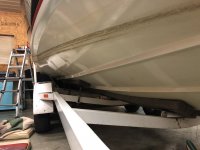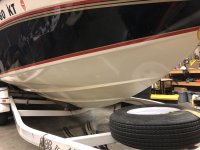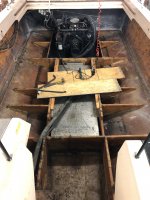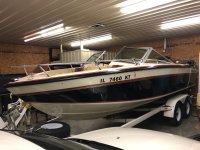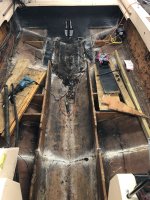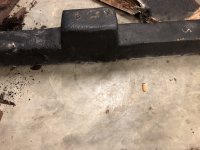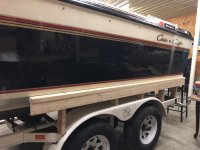Jumping in head first into a world unknown, any and all guidance along the way will be very much appreciated. I’m pulling the engine Saturday. After getting all the mechanical stuff out and a thorough scrub down, I’d like to get busy on a sturdy cradle. Definitely need some advice on this...
I would like to do everything on my bunk trailer, if possible. My thought was to intertwine added supports with the trailer so I can roll it out of my pole barn for sanding. As can be seen in the pic below, there are two bunks on either side. My thoughts are to add an additional bunk on each side as well as building supports on the front to support the bow.
Is it ok to do it this way? Should the transom be supported from the sides at all if I’m replacing it? Any other areas need support that I should be addressing?
Once the hull is properly supported, the plan is to take the cap off, gut most of the wood and sand sand sand. Then start building, starting at the transom and work my way forward. I have some more core samples to drill, but realistically the only wood I plan on being able to leave are the little wedges of bulkheads that frame in engine, gas tank and ski locker. All of those are solid with no rot and thought they would make a good guide as I replace everything else.
Also, was wondering if anyone knows of any good resources that would be a good step by step guide to this process? I’m finding so many different methods and opinions on the internet. I may be green to this but I know better than to believe the guys on YouTube building transoms out of pressure treated plywood, drywall screws and liquid nails
I would like to do everything on my bunk trailer, if possible. My thought was to intertwine added supports with the trailer so I can roll it out of my pole barn for sanding. As can be seen in the pic below, there are two bunks on either side. My thoughts are to add an additional bunk on each side as well as building supports on the front to support the bow.
Is it ok to do it this way? Should the transom be supported from the sides at all if I’m replacing it? Any other areas need support that I should be addressing?
Once the hull is properly supported, the plan is to take the cap off, gut most of the wood and sand sand sand. Then start building, starting at the transom and work my way forward. I have some more core samples to drill, but realistically the only wood I plan on being able to leave are the little wedges of bulkheads that frame in engine, gas tank and ski locker. All of those are solid with no rot and thought they would make a good guide as I replace everything else.
Also, was wondering if anyone knows of any good resources that would be a good step by step guide to this process? I’m finding so many different methods and opinions on the internet. I may be green to this but I know better than to believe the guys on YouTube building transoms out of pressure treated plywood, drywall screws and liquid nails




















